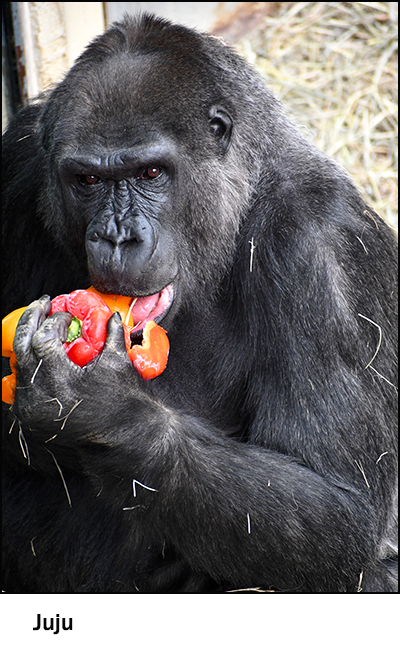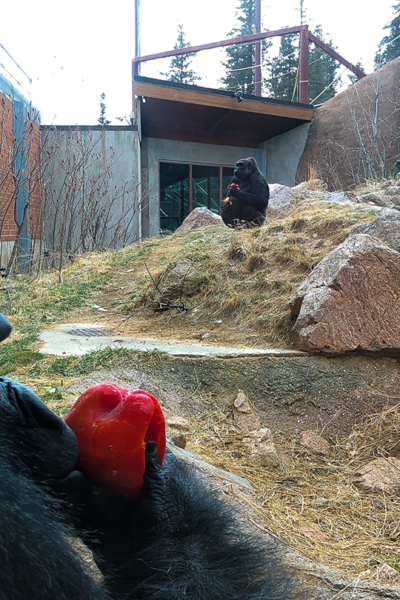After seven years of settling in, the Western lowland gorillas at Cheyenne Mountain Zoo are officially a cohesive troop! 32-year-old Goma – the troop’s silverback – is living with the four females full-time, which means they’re ready to take the next step as a family.

Goma came to CMZoo on a breeding recommendation in 2016. Joining a tightly bonded group of females was no easy task for the silverback, who came from a bachelor group without much experience living in a traditional family unit. He had to learn how to lead and communicate with females, 30-year-old Asha, 30-year-old Kwisha, 42-year-old Juju and 46-year-old Roxie.
“It’s a fine line because he had to gain their respect, but also show them respect,” said Jon Wild, lead keeper in Primate World. “Now that they’re living together comfortably all the time, we can start working on one of the main reasons he came here: to hopefully help bring a bundle of joy to the group.”

The Western Lowland Gorilla Species Survival Plan recommended Goma and Asha to breed, and although Goma has no experience in that department, they’re hopeful Asha will lead the way. In the coming months, keepers will end Asha’s oral contraception (birth control).
Keepers have seen ‘flirting behavior,’ from Asha, where she’ll sit extra close to Goma or stare intensely at him. She throws hay and plays near him to get his attention, but Goma hasn’t responded. The end of birth control means Asha’s hormones will shift, so it’s likely she’ll be even more motivated to get on his radar. If Goma were human, some might think he’s playing hard to get. What’s more likely is that inexperienced Goma simply doesn’t know what to do yet.
“We haven’t seen any breeding behavior from Goma yet,” said Eleanor Knox, senior keeper in Primate World. “That’s not the case with confident Asha. She’s quite interested in him. Asha and Goma sit, sleep and eat comfortably near each other, within about five feet, which is promising. He’s learned so much already, so we’re hopeful he’ll be able to learn this new role, too.”
Asha has experience as a teacher. She previously taught breeding behaviors to another silverback. Of all the females, keepers say Asha led the way in helping Goma get settled into the troop. With the change in her hormones, the rest of the troop will likely adapt to her behaviors, too.

They’re a family that lives together 24/7, so, like any family, they have disagreements and they work them out in their own way. To communicate they’re not thrilled with something that’s happening, gorillas will ‘stiff stance,’ which is when a gorilla stands on all fours with stiff front arms while facing another gorilla intensely. They also chase, vocalize, or make noise with objects near them. This might look alarming to the untrained eye, but it’s all normal conflict resolution for gorillas.
Juju has mellowed out in her advanced age and after bouts of health issues. She very rarely initiates conflict anymore. However, she’s happy to participate with a grunt from a distance and a little chase, or she might dish out a signature ‘bop’ on the head as someone chases by her.
Because the keepers know the gorillas so well as individuals, they can identify behavioral changes and look for physical changes that could indicate pregnancy. Weight is a factor, but gorillas are naturally round-bellied, so keepers will depend on scale training and specific weights, rather than whether a gorilla ‘looks pregnant.’ Similar to humans, gorilla pregnancies can also be confirmed with a urine test.

“Guests sometimes ask if they’re pregnant now,” said Knox. “Asha and Kwisha, our younger two females, have round bellies. It’s understandable why guests might think that. Obviously, if there’s a pregnancy, no one would be more excited than us, and we would be shouting it from the mountainside when the time is right.”
The team is hopeful for a baby for a variety of reasons. Having kids in a gorilla troop generally helps make a cohesive troop even more bonded. Asha has two offspring, 16-year-old female Tumani and 10-year-old male Dembe, who now live at other zoos accredited by the Association of Zoos and Aquariums. Having young gorillas in a troop is a natural part of gorillas’ dynamic and it’s enriching for everyone to have a baby around.

“Roxie is in the last years of her life, and she has loved playing with the kids in the past,” said Knox. “We would love to see her enjoy that role as a grandma one more time. We also want to help maintain the species, and there’s nothing like a baby to get people’s attention and inspire a new generation of conservationists.”
Western lowland gorillas are critically endangered in the wild. In addition to disease and poaching, they face habitat loss due to logging for agricultural use, human settlements and mining. Many of the west African lowland forests and swamps that these animals call home contain natural deposits of coltan, a mineral used in cell phones and other electronics. Due to the ever-increasing demand for cell phones across the world, the destruction of these gorillas’ habitats for mining purposes has unfortunately only increased.
Coltan is recyclable, and by donating old cell phones, gorilla advocates can supply valuable coltan for future phone production. In Primate World, guests can deposit their old and unused cell phones in a recycling bin near the gorilla habitat. CMZoo sends them to Eco-Cell, an organization that recycles the phones, as well as tablets, smart watches, Bluetooth devices, GPS devices, e-readers, digital cameras, handheld gaming systems and their accessories.
CMZoo will provide updates on the gorilla troop’s progress as the group reaches milestones.

